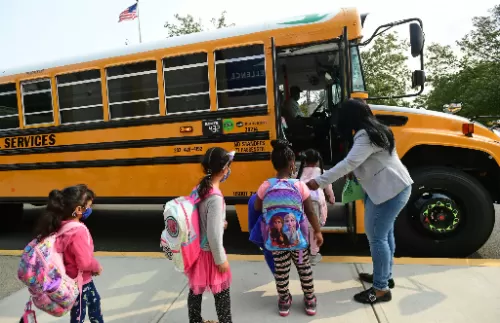
Transforming Classrooms: How Educational IT Is Reshaping Learning in America

Unpacking the Core of American Education: What Defines a High-Quality Curriculum

How Can Teachers Use It in Instruction? Practical Strategies for the Modern Classroom

Early Educators Face Growing Strain as Preschool Expansion Stalls

The Future Is Virtual: How Online Teaching Is Redefining American Education

History Class Can Foster Literacy Skills: A Hidden Power in the Curriculum

Closing the Divide: Tackling the Gender Gap in U.S. STEM Education

Education Department Adds $60 Million in Grants for Charter Schools

What Makes Schools Safe: A Holistic Look at Security, Belonging, and Preparedness

Supporting English Learners in Today’s Classrooms: A Path to Equity and Opportunity
Early Educators Face Growing Strain as Preschool Expansion Stalls
After years of bipartisan support and investment, the expansion of preschool programs in the United States is showing signs of stagnation. Recent reports indicate that while demand for early childhood education remains high, enrollment in public preschool programs has plateaued—and in some areas, even declined. Behind the numbers lies a deeper issue: a strained early education workforce struggling to meet the needs of families, especially as wages remain low and burnout runs high. As preschool growth halts, early educators are once again at the center of a national conversation about care, equity, and the future of public education.
Related searches

The Rise and Pause of Preschool Expansion
Over the past two decades, state-funded preschool programs have seen unprecedented growth. Supported by studies linking early education to improved long-term academic outcomes, policymakers in both red and blue states poured millions into expanding access for three- and four-year-olds. Programs like universal pre-K in New York City and Georgia’s long-standing lottery-funded system became national models.
However, the COVID-19 pandemic disrupted that momentum. Classroom closures, shifting budget priorities, and workforce attrition created setbacks that many programs have yet to recover from. According to the National Institute for Early Education Research (NIEER), total enrollment in state-funded preschool has remained flat since 2021, with little sign of acceleration in 2024.
A Workforce Crisis Hitting the Front Lines
At the core of this stagnation is an ongoing crisis among early childhood educators. Despite being the backbone of preschool delivery, early educators continue to face low wages, minimal benefits, and limited career advancement. According to the Bureau of Labor Statistics, the median pay for preschool teachers remains under $35,000 per year—less than half the salary of a K–12 public school teacher.
This disparity has led to high turnover rates and difficulty recruiting qualified staff, especially in underserved communities. Centers often operate below capacity simply because they can’t hire enough teachers to meet state-mandated ratios. The result? Waitlists grow, classrooms sit empty, and families—especially working parents—struggle to find reliable care.
Uneven Access Exacerbates Inequity
While some families in affluent zip codes can afford private preschool programs or find seats in well-funded public options, low-income and rural communities are disproportionately affected by the slowdown. Children in these areas are less likely to attend a high-quality preschool, despite being among those who benefit the most from early learning opportunities.
States like Alabama and Washington, which had been praised for efforts to expand preschool equity, now face difficult decisions about funding priorities. In the absence of sustained federal investment, many programs are being forced to scale back outreach and classroom sizes. For parents, this translates to long commutes, limited options, and higher costs—especially for part-time or flexible-care arrangements.
Federal Ambitions, Local Realities
In 2021, President Biden’s Build Back Better plan included bold promises to fund universal preschool nationwide. While the proposal passed the House, it ultimately failed in the Senate, leaving many educators and advocates disappointed. Since then, only modest federal support has materialized, mainly through pandemic recovery funds that are now beginning to expire.
Local and state officials, left without consistent federal backing, are trying to do more with less. But without systemic investment in early educator compensation and training, many programs are hitting a wall. Pilot programs and city-level initiatives offer some hope, but they are not a substitute for national reform.
The Need to Elevate Early Educators
Experts agree that any solution to the preschool stall must begin with the workforce. Elevating early educators—through pay increases, certification pathways, and professional development—is critical not just to recruitment, but to program quality. Research shows that stable, well-supported teachers improve child outcomes and create more resilient learning environments.
Several states, including New Mexico and Illinois, have begun implementing wage supplements and credentialing programs to support early childhood staff. These policies are promising, but they must be scaled and sustained. Without serious attention to those on the front lines, the entire early education system risks regression.
A Crossroads for Early Learning
Preschool in America is at a crossroads. While the vision of universal access remains alive, the path forward is murky without robust, sustained investment—particularly in the people who make early learning possible. As the sector grapples with labor shortages, stagnant enrollment, and widening inequities, early educators continue to carry the weight of a system in transition.
For families, communities, and policymakers, the message is clear: early education can’t expand if the workforce is breaking. To ensure a brighter future for the next generation, we must prioritize not just classrooms and curriculums, but the dedicated professionals who bring them to life.
 By: Erin Lin
By: Erin Lin

